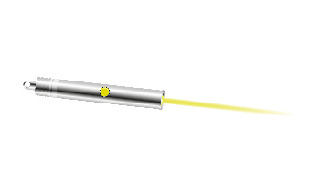
Laser with visible radiation is an important technology used in various fields, including Dentistry.
The term “laser” originated as an acronym for Light Amplification by Stimulated Emission of Radiation. It has been used in stomatology since 1989 and with the development of this technology, a variety of lasers have been created. The material that generates the laser can be a solid, gaseous, liquid, or semi-conductive element and its designation depends on the material used in its composition.
Laser Types
Solid-State Lasers: They are made of generating materials distributed in a solid matrix. Examples include neodymium lasers and ruby lasers.
Gas Laser (helium and helium-neon, HeNe). These gas lasers are the most common and have a visible red light. They are used to cut resistant materials and radiate infrared beams with a long wavelength.
Dye Lasers: use complex organic dyes such as rhodamine 6G, in a liquid solution or suspended, as the main material for laser creation. They are adjustable to various wavelengths.
Semiconductor Lasers: Also known as a diode laser. They are very small electronic devices and use little energy.
This type of laser has various applications in dentistry. It is based on GaALAs crystal. If stimulated, it emits a laser light, which is sent via optic fibre to the treatment area. This laser is specially used for soft tissues and is effective in root canal treatments and surgeries. In this case, an extremely accurate cut is made in the gum tissue without any damage to the surrounding area. The blood clots while the cut is being made. Anaesthesia is not needed during this procedure.
Erbium Laser: Its active ingredient is erbium and this laser is specially used for hard tissues. It is used in pulse mode. Water molecules in the target area are superheated, and thus, tissues are removed. It is a replacement for the drill to cut enamel and dentine in teeth and maxillary bone.
Major Applications of Laser Technology
Periodontics, Oral Surgery, Aesthetic, among others.
Laser Benefits in Dentistry
It has an anti-inflammatory, analgesic, and bio-stimulant effect.
The laser can be used as a relief for different types of pain, such as pulp or neuralgic pain, myalgia, and preoperative or postoperative pain. It repairs tissues after root canal treatments or traumatic lesions. It decreases oedemas and is extremely effective in periodontal treatments such as gum inflammation, curettage, and repairing tissues that support the tooth. This method can also be used as pre-anaesthetic as it decreases discomfort while applying the anaesthesia. It promotes an increased microcirculation.
Using laser has other advantages in dentistry as it can be used for treating TMJ disorder, facial paralysis, tooth decay, herpes, alveolitis and trigeminal neuralgia.
This method makes surgeries less invasive. In addition, while cutting the tissue it causes clotting and closes the lymphatic vessels as well as nerve endings.
The surgical laser is also utilized to remove tooth decay and has the advantage of not needing anaesthesia. It accurately removes the affected tissue and may provide more endurance to the tooth surface.
Another advantage is that some studies have shown that using a carbon dioxide (CO2) laser together with fluoride can prevent tooth decay in over 84% of cases. The laser creates a barrier on the tooth surface, which prevents acid penetration and, thus, prevents dental demineralisation.
Laser Technology Contraindications
- If there is a malignant tumour in the target area.
- In cases of hyperthyroidism, epilepsy or retina exposure.
- During pregnancy.
Risks of Laser Use in Dentistry
The lack of appropriate training of some professionals and misleading advertising of some commercial brands that want to increase their sales of laser devices. In this case, they present biased protocols with no scientific evidence supporting the concept. When a clinic intends to acquire this type of device, it is extremely important to assess the credibility and renown of the commercial brand.
The light should be well-aimed and absorbed without damaging the adjacent structures. The dentist should use safety glasses to protect the eyes. The cornea and retina are sensitive areas that should be protected.
Vita Center Medical Reference- Reviewed by VitaCentre Dental Clinic Staff on May 29, 2022
References / Bibliography:
- Matsuyama T, Aoki A, Oda S, et al. Effects of the Er: YAG laser irradiation on titanium implant materials. Journal of Clinical Laser Medicine and Surgery 2003; , 7-17.

